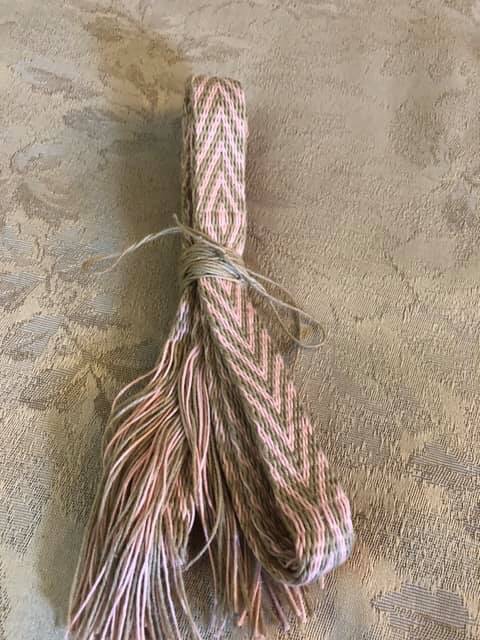A year ago this week, I took a beginner tablet weaving class, and came away with a basic understanding of how to turn cards in a variety of ways to create a shed, and a sampler to take home.

I really had no idea how to get the warp threads ready for weaving, or how to design a pattern, let alone actually weave the pattern. Plenty of practice led to a variety of what I consider “learning experiences” or “frustration followed by unexpected results”… some of which were actually pretty nice, just not what I wanted to accomplish and I’m not even sure I could replicate them?

The two useable pieces went to a fundraising auction! I was determined to make at least a single, simple reproduction piece. Using instructions from Shelagh Lewins, I settled on the narrow band from Oseberg.

A few passes (left) where it looks like something but not necessarily the pattern, and then I finally figured it out. One card was facing the wrong direction. There is so much in tablet weaving that can affect the outcome, I was a bit over the moon to have that breakthrough! I broke out the linen, and made myself a fancy belt with the Oseberg pattern in between a border I made up for myself. I had to braid the end bits, I couldn’t figure out how to twine them and have it all stay in place.

This year for Christmas, I was gifted with The Techniques of Tablet Weaving by Peter Collingwood. So I’ve been using cotton and trying out techniques one after another. I’m finding it easier to accept my own mistakes, and to work through why they happen and how to fix them. Sometimes I can weave backwards and correct myself, but often I just leave a space and try again. Sometimes I am able to catch myself before I make a mistake, and that is golden!




Trying out staggered direction changes. The first couple feet of weaving is a bit random, as I get used to the rhythm of the pattern, and try variations (right). Then I am able to produce an even effect for a length (left)! This I call success!


Leave a comment